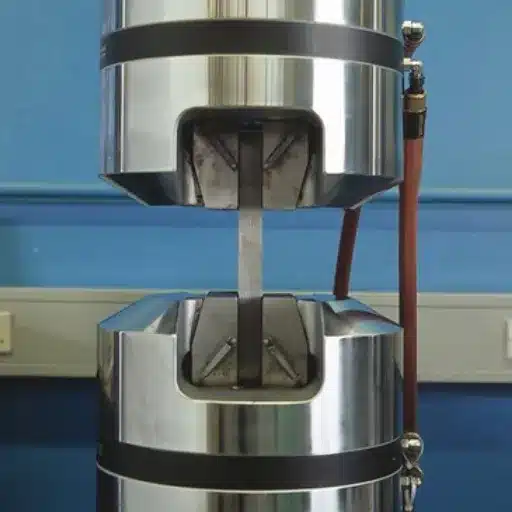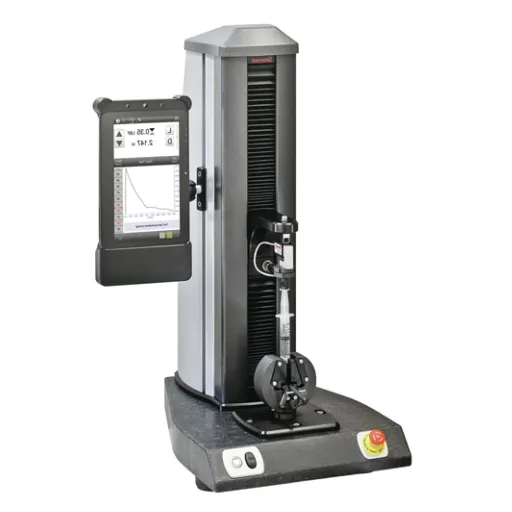Concrete compression testing machines provide a solid backbone in modern construction as an aspect of technical control over the produced works; being one of the most common construction materials in the world, concrete needs careful consideration with respect to its properties. Agile infrastructure and construction designs make it even more apparent why every contractor should know how this equipment works and have absolute reliance on them within the limitation of the construction test. The present paper introduces the reader to the complexity of the concrete compression testing machine, their importance, operation, and the efficiency with which measurements can be performed to assess any construction. All of this information should be considered by constructing an in-depth plan for those whose profession involves carrying out tests and for those who wish to delve into the subject for its own technical purposes, there are explanations as to how these tools work.
What is a Concrete Compression Testing Machine?
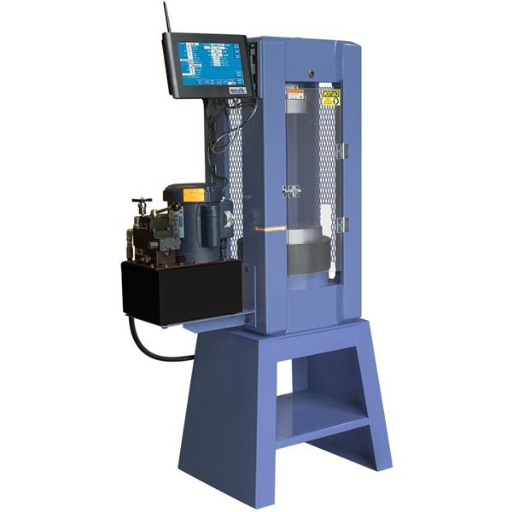
A concrete compression testing machine is a machine or equipment employed for determining the compressive strength of concrete samples fashioned into cubes or cylinders. It presses the material progressively with a known predetermined force until a fracture occurs. In turn, determining how tough and efficient a concrete product will be is especially important in the construction industry. Basically, this machine is made up of a frame for creating force, a hydraulic unit for controlling the loading force and pressure, and a digital reading meter. Extensive tests of this nature provide assurance that the concrete sub grades which are used have achieved the appropriate requirements level.
Understanding the Basics of Compression Machines
A concrete compression testing machine is an indispensable instrument found in any materials testing laboratory. Its prime construction is for ascertaining the compressive strength of concrete, mortar, and stone. The machine applies compressive force on a given substrate until it fails, determining the structural efficiency of that substance in question. Newer generations incorporate load cells for accuracy in measurement of applied force, test automation to suit the international test methods,-enable and enhance further processing of test results using data acquisition systems. Compression testing machines help in the process of ensuring consistency in the results obtained which is key in quality control measures in construction or any other industrial sectors.
Key Components of Compression Test Machines
1.Frame for Load
The load carrying frame performs in the manner of assuring the ability to survive very high compressive loads without any distortion damage. Commonly made of tough steel, sometimes alloy reinforced, it gives durability and accuracy when testing cycles are repeated. The inclusion of adjustable platens allows the manipulation of varied sizes of the specimens.
2.Cell for Loading
The load cell is one of the critical elements if not the most for it gauges the compressive load/pressure applied on a given object to a very high degree of precision. In the case of modern version compression machines, load cells made of strain gauge are used for there is a change in strength level which is noticeable and readings are given in different degrees. The information is important in respect to understanding how well a material will react to varying pressures.
3.Devices for Compressing either Driven by Hydraulic or by Screws
This is the actuator, which is used to provide the compressive load required for carrying out the test. The hydraulic actuators are preferably used due to the ability to produce high extent of load level very easily, whereas the screw driven systems are better in controlling the load for smaller samples as compared to the hydraulic systems meant for larger samples.
4.Data Acquisition System (D.A.S.)
A more complex DAS logs data obtained during the tests in real time. The system collects such information as forces, displacements and strains after which all data is input into one software package for further evaluation purposes. Faculties also provide computer compatible systems for displays and report processing purposes in compliance with principles including those of ASTM and ISO.
5.Control of the System
The doing of the control system includes the general functions involved in operating the machine such as the whether the load is applied and for how long as well as the limits it functions within. Programmable logic devices fitted with illuminated displays allow customization and viewing of test operations. In some systems, there is also an option of changing test styles to suit the most widely used standards in testing.
6.Plates and Fixtures
Strong plates more often tempered or case-hardened in addition to performing the above functions also help distribute stress over the surface of the sample. Some even come with specialized anti-friction pads like spherical seatings that correct any alignment discrepancies that may arise enhancing the accuracy and reliability of the test.
7.Variability of Elements Creating Safety
Compression testing machines have several safety mechanisms that include overload prevention, emergency stop systems, and protection covers during the process to avoid any accidents. Such mechanisms provide safety to the operator and the equipment as well.
All of these components are designed and compacted in a Impeccable manner to be able to run compression tests enabling the collection of data critical to structure and material design and concrete compression testing machine.
How Concrete Compression Testing Machines Work
The control system of a typical concrete compression testing machine manages a step-wise increase in the compressive load until the specimen fails. The test involves placing the specimen, usually a cylinder, cube or prism on the loading platform of the machine. The aim To achieve this, oil pressure is used to exert the force through oil filled cylinders recorded as relative kilonewtons.
The system uses a set of load cells and motion sensors that enable an operator to see the load being applied. This enables measurement of the displacement of the sample either by eye or by the use of strain measuring devices, displacement gauges and/or strain gauges. All these machines are adjustable for accuracy and meet international standards such as ASTM C39 and BS EN 12390. The report obtained consists of the maximum load applied, compressive strength and serves to determine whether the material fails or satisfies the design requirements for construction.
How to Conduct a Compression Test on Concrete?
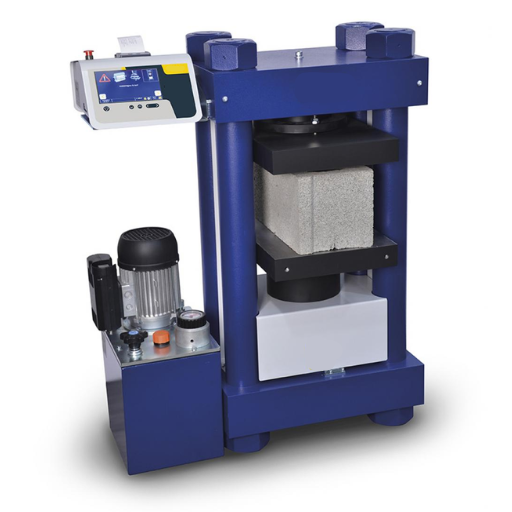
Inspections and preparation prior to the start of a concrete compressive stress test are as follows:
1.In preparation: The specimen must be a suitably cured concrete sample in a shape appropriate for measurement, a cylinder or cube, observing the required time period according to the standards such as ASTM C39 or EN 12390. Any surface deformation should be eliminated and under any allowed deviations dimensions should be checked.
2.Machine Assembly and Calibration: The concrete compression testing machine should be correctly calibrated, so that every applied pressure is perfectly measured to avoid errors. A specimen is then set on the system of supports to be thoroughly tested for a possibility of an eccentricity.
3.Application of Load: Apply the loads in a slow continuous manner in accordance with the specified standard rate of loading. If it is necessary to take further deformations, such equipment as strain gages or dial indicators should be used.
4.Measures of Performance: The load is increased until greater than the capacity of the specimen and the maximum load is recorded and used for the computation of the compressive strength.
5.Data Outlay: The difference between the obtained results and the constructed size or standard would then be used for the assessment of the burnt cement acceptable level.
Preparing Concrete Cylinders and Specimens
When I am working with concrete cylinders and samples, I always follow the prescribed steps religiously to ensure precision and quality control. At this point, I measure the cement, water, and gravel and then weigh them followed by blending and casting them all in unison. Before anything else, every pocket of air, every void, every hollow is filled by careful tamping or gentle vibration of concrete within forms. Later, the test specimens are cured at fixed temperatures, usually by suspending them in a humid room or immersing them in water. Prior to evaluating these elements, I ensure the dimensions and curing histories of the necessary samples have been adhered to so that analysis can be conducted with as much consistency as possible. Such procedures prevent any degradation of the structures as well as the tested concrete because of the application of the compression force in a concrete compression testing machine.
Steps to Perform a Compression Test
1.The Formation of Testing Samples
Prepare a concrete mix for preparing cylindrical and cube samples as per applicable standards. Ensure that Concrete is poured properly with a jar shaking not let Air bubbles to form.
2.Curing the Concrete Samples
Place the formed samples in a separate chamber constructed to store such samples up to the required period. A controlled climate may be a room with cooling and humidification facilities or tanks with water. This allows the samples to meet the specifications for temperature and humidity conditions as stated in relevant standards.
3.Inspect the Shape and State of the Sample
Check the shapes of the samples and look for imperfections, if any exist. Remember that the samples should correspond to the standards for tests and the curing period for the samples should expire.
4.Adjust the Compression Testing Equipment
Ensure that the compression testing machine has been calibrated in accordance with the manufacturer’s guidelines; perfect working order also needs to be checked.
5.Direct the Specimen
Ensure that the test specimen is placed and/ or as centrally as possible on the base of the testing machine and material centerline to help eliminate an unwanted load spread and help distribute the force that is exerted thereon, uniformly.
6.Introduce the Ram Load
Begin the loading in accordance with the required type of loading, for instance in compliance with ASTM or ISO standards. Continue loading at this rate during the entire test to prevent inaccurate results.
7.Log the Load at the Moment of Failure
Wait until the sample completely fails and record the load (compressive strength) supported by the specimen.
8.Record and Interpret Tests Results
Take down the observations on testing results, including how the test piece fails, compressive strength and variance if any in the testing process. Evaluate this information against the required design or acceptance values.
9.Discard Used Samples
All the broken samples are to be sensibly removed and discarded, as per the guidelines in the facility and without breaching the standards of environmental safety.
Everyone is in a position to understand and recall the protocol in steps and the problem when calculating concrete compression testing machine does not arise.
Interpreting Test Data and Results
In order to correctly judge the results of a sample compressive test, the actual strength achieved from the test specimens should be checked with respect to design strength/specified standards. It is important to understand the mean values of the strengths of the cubes tested and reassess if they meet the standards needed for the specific purpose. Consider any unusual results that occur, for example, positive or negative outliers, which may point to other issues such as material problems, wrong curing times or faulty testing equipment. These fluctuations of the results can be sorted out depending on the use of some statistics, and can be expressed in terms of standard deviation, which serves to understand the roles of quality assurance. In addition to that, look into the pictures of the destruction of a material tested to see its behavior under load preferably with an understanding of the validity of the design or any other problems that may come out and necessitate some action.
Why is Compressive Strength Important in Concrete?
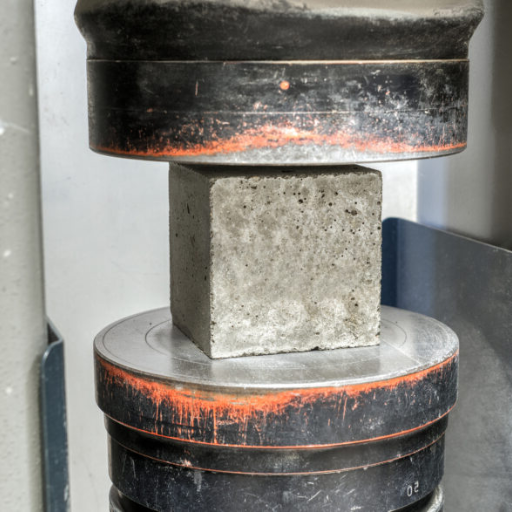
Compressive strength plays an important role in concrete as largely it is the strength of a structure which decides its load bearing capacity. Hence, compressive strength is a basic characteristic of concrete indicating its structural ability and durability. Mostly it helps in the designing of the elements and performing in-situ as well as in lab checks for the control of quality. The level of compressive strength may also imply structural ability to support loads such as conscious and even unconscious designs of structure which include infrastructure and architecture as well as conditions of the environment. Therefore, this characteristic is of great importance in designing the materials and assessing the material in terms of quality assurance.
The Role of Compressive Strength in Construction
Compressive strength determines whether materials, including concrete, stone, and steel, could be used for various constructions. In most cases, compressive strength is expressed in megapascals (MPa) or pounds per square inch (PSI), depending on the country. For example, ordinary structural concretes have strength within the range of 20 MPa (2,900 PSI) up to 40 MPa (5,800 PSI) whereas high-performance concrete or special types can be produced having strengths more than 14,500 psi (about 100 MPa) depending on the constituent materials used. This range helps the material to bear high levels of stress especially when applied to tall structures bridges or any other type of heavy duty construction.
There are several procedures employed in determining the compressive strength of a material; cytokinesis in Europe is one of those – cylinder compression tests on concrete follows ASTM C39 standards in the US. The tests are usually done at 7, 14, 28 days for understanding the suitability of materials with ageing and developmental designs. The compressive strength objectives in constructed items include minimizing the risks of failure and improving the ability of such items to carry loads.
As far as basing lists upon technical rules is concerned, there are certain chemical and mechanical components: water-cement ratio, type and gradation of aggregate, curing regime and admixture application that may alter compressive strength. Consequently, if more water is used, then less cement shall be used which means lower water-cement ratio promises more dense material. Similar argument prevails for bad curing in which hydration of cement – the very reason why cement is used – does not take place to the extent wished for, thus lowering cement strengths. Pozzolanic materials (silica fume, fly ash etc.) can be added to concrete to produce high strength and durable concrete.
By managing each of these parameters correspondingly, engineering can satisfy customer as well as Authorities’ requirements while ensuring that the structure will remain intact for the anticipated life span.
Difference Between Compressive Strength and Flexural Strength
Compressive strength measures a material’s resistance to axial loads without breaking, while flexural strength evaluates resistance to bending or tensile forces.
|
Parameter |
Compressive Strength |
Flexural Strength |
|---|---|---|
|
Definition |
Axial load resistance |
Bending resistance |
|
Load Type |
Compressive |
Tensile/Bending |
|
Testing Method |
Cube/Cylinder tests |
Beam tests |
|
Stress Types |
Uniform across section |
Mixed (tensile at bottom) |
|
Typical Values |
Higher (MPa) |
Lower (MPa) |
|
Use Case |
Columns/Foundations |
Slabs/Beams |
|
Material Focus |
Bulk strength |
Surface/Tensile properties |
Factors Affecting Concrete Strength
1.Water-to-cement mass proportion
The water:cment ratio has a crucial effect on the concrete’s compression strength. Typically, the smaller the ratio, the higher the strength as less porosity translates to increased compactness of the concrete mixture.
2.Curing regime
Correct curing is essential to obtain the most desirable strength of concrete. Hydration is influenced by temperature, moisture and the time of curing and this has a bearing on the development of strength.
3.Properties of aggregates
Constituenta ggregates are significant determinants of the strength of any concrete structure especially at the raw materials stage. Concrete aggregates should be graded. Granular particles of little or no dust are better since they enjoy deeper penetration and more efficient transfer of forces during use.
4.Type of cement and its strength characteristics
Cements can be numerous and each cement is composed of its fractions and media. This affects the rate of hydration and thereby, the ultimate concrete strength.
5.Compaction and mixing
Thorough mixing ensures that the components are evenly administrated whereas proper compaction serves to expel air trapped within the mass, hence produces a much compact and durable concrete structure.
What are the Types of Compression Test Machines?
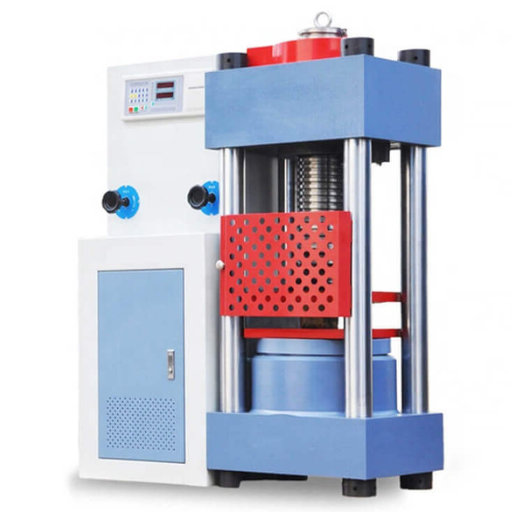
Compression test machines encompass several types, including universal testing machines, hydraulic compression testing machines, servo-controlled testing machines, and digital compression testers.
|
Type |
Operation |
Controls |
Accuracy |
Capacity |
Usage |
|---|---|---|---|---|---|
|
Universal |
Manual/Elec |
Manual/Digital |
High |
Variable |
Versatile |
|
Hydraulic |
Mechanical |
Manual |
Moderate |
High |
Concrete/Steel |
|
Servo-Controlled |
Automated |
Digital |
Very High |
Adjustable |
Precision Tests |
|
Digital Tester |
Electronic |
Digital |
High |
Limited |
Laboratory Use |
Manual vs. Automatic Concrete Compression Machines
Manual concrete compression machines are cost-effective and durable, whereas automatic machines offer precision, efficiency, and advanced features.
|
Key Point |
Manual |
Automatic |
|---|---|---|
|
Cost |
Low |
High |
|
Durability |
High |
Moderate |
|
Precision |
Moderate |
Very High |
|
Operation |
Manual |
Automated |
|
Efficiency |
Low |
High |
|
Training |
Minimal |
Required |
|
Maintenance |
Rare |
Frequent |
|
Usage |
Basic Tests |
Precision Use |
Features of High-Performance Compression Machines
1.Load Sensing Mechanism: Such equipment is fitted with load sensors which offer the unerring force measurement during the processes, thus, improving the accuracy of the process.
2.Advanced Control System: The machine is very sophisticated with integrated and programmable control units which assist in designing the testing processes, enabling similar operations which can be repeated several times.
3.Engineering Frame: These types of machines are built for high-force testing without sacrificing any structural integrity and precision.
4.Analysis of Data in Real-Time: Monitoring of the tests, storing of the test processes and other recorded data as well as the analysis of the tests can be carried out instantly using the available inbuilt software system. This increases productivity and aids the control of the processes.
5.Application Testing Capability: The machines facilitate a variety of tests extended to both compressive and tensile tests which meets the demands of the users in various sectors.
Choosing the Right Compression Test Machine for Your Needs
In order to obtain a testing machine which can compress concrete within the required range, I have to explore the feasibility of different aspects such as the flexural capacity, sizes of specimen and types of materials to be tested. These include determining the level of force suitable for the application and whether the machine is capable of delivering the accuracy levels desired for the application. I also look into the type of tests that I will perform whether it is Compressive strength, flexural testing or fatigue testing material and whether there are any mandatory features that I should look for in a compression test machine.
Then, I take into account the software provided and data analyzing functions as they have to contain features such as real-time monitoring and high detailed reporting of the tests performed since these make working on those results faster and more productive than otherwise; ensuring the use of such machine is more actionable. Such software solutions and export options candidature are important to ease the day to day work process. Finally, I evaluate whether the machine is versatile enough to cover numerous test processes and durable enough to work over an extended duration without failing against such restrictions. This criteria helps in making a selection of a concrete compression testing machine that is compatible with the desired specifications and performance expectations.
How to Maintain and Calibrate Concrete Compression Testing Machines?
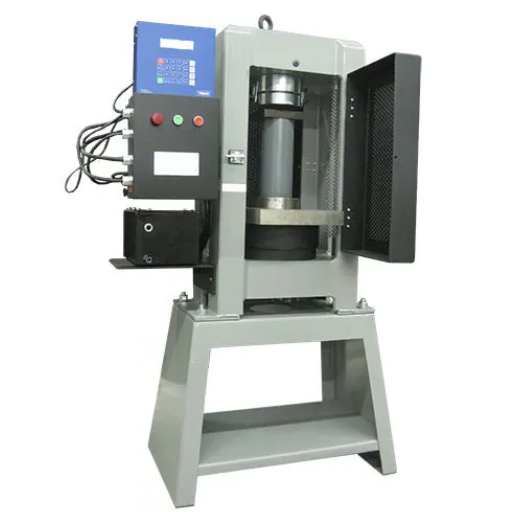
That needs to be done in order for concrete compression tests to be conducted and the results gotten to be reliable all the time. Full service includes dust elimination as dust tend to accumulate in the machine, checking the unit for oil leakages, assessing connections for wear and correcting them, lubricating lubricable surfaces to reduce friction, promote service life, and many others. It is advised to carry out calibration on the machine using only qualified and traceable calibration standards according to class grades specified in the consumer class table. One must also test the compressibility of the machine in a few different zones of work to comply with the requirements. Day-to-day maintenance practices and respect for serviceable hours and schedules could keep the machine operational for a very long time and without causing any defects.
Best Practices for Machine Maintenance
Standard maintenance procedures include conducting regular inspections for signs of wear, cleaning components to avoid buildup of debris, and lubricating moving parts for ease of operation and longer life. The important systems are serviced strictly based on the service manuals and the prescribed schedule using qualified instruments for adjustment or any repair. Moreover, it is essential not to forget about the log of the entire maintenance for the purpose of tracing the state of the machine and maintenance practice within standard.
Steps for Accurate Calibration
1.Read The User’s Manual: This simple step is crucial before putting your hands on the tools for calibration, so you can use them according to the outlined methods and the acceptable range.
2.Clean The Devices: If the machine is a tool, clear it from all branches, and leaves upon which the anterior caps. Check for any breakages in any of the elements and carry out pre-operation tests where necessary.
3.Gather Calibration Equipment: Make use of calibration apparatuses such as multi meters or Vernier calipers or calipers themselves or even some specialized meters, which are verified and in perfect working conditions in their calibration period.
4.Set Ambient Conditions: Perform calibration in a controlled environment, Addis ababa university enclosed within the walls of the laboratory. Where the temperature does not vary. the humidity is surfacekeeping. And on all these light is also provided in order to avoid any variables arising, affecting the precision.
5.Implement the Calibration steps: Adjust the calibration procedures of the equipment as stipulated in the respective instructions. It could entail shifting of zero point, changing the instrument scale or adjustment of control parameters.
6.Check Accuracy by Using Reference Standards: Attach a reference value other than zero so as to help in documenting the boundary limits and interpreting irregularities.
7.Perform Adjustments: In case there is a variance between the measurements and the specified values, adjust the equipment further to meet the requirements as stated.
8.Inspect Again and Do a Rerun: Confirm the calibration procedures to be accurate and consistent, when all the operation modes are still balanced, after making the changes.
9.Use Calibration Records: This may consist of the calibration procedure, calibration results and any changes made during calibration among other things. These records are kept for future cross-checking and also for purposes of audits.
10.Provide the Equipment with Calibration Information: Including the date of calibration, and an exact date for the next calibration. Refrain from Removing the tags.
Ensuring Accurate and Repeatable Test Results
For reliable and consistent outcomes when testing, follow a stringent methodology which encompasses verification of the system, controlling environmental conditions and maintaining the equipment. It is important to first standardise the practices of testing and utilize precision quoted, calibrated instruments to reduce variations. Environmental aspects such as temperature, humidity as well as vibrations are to be controlled since these factors can form unnecessary differences in the findings. Ensure that all measurement instruments are calibrated and preventive service is performed on a regular basis and every process shall be recorded to enhance accountability. Finally, adopt strong quality assurance systems such as data comparison and cross checking, so as to show that repetitions of tests are both possible and consistent.
Reference Sources
-
Gilson Basic Concrete Compression Machines – Provides details on manually operated machines for compressive strength tests.
-
Forney Compression Testing Machines – Offers insights into durable and high-performance compression machines for lab and field use.
-
An Innovative Test Method for Tensile Strength of Concrete – Discusses a new method for testing concrete tensile strength, which complements compression testing.
-
Compressive Strength of High-Strength Concrete – A research paper from NIST exploring systematic studies on testing machines and their effects.
-
Strength-Testing Machines for Concrete – A ResearchGate publication detailing various machines used for determining concrete strength.
Frequently Asked Questions (FAQs)
Q: What is a concrete compression testing machine?
A: A concrete compression testing machine is a device used to test the compressive strength of concrete samples, such as concrete test cylinders, by applying pressure until the sample fails. This is a standard test in concrete testing to ensure materials meet required strength specifications.
Q: How does cement compression testing differ from standard concrete testing?
A: Cement compression testing specifically measures the compressive strength of cement materials, whereas standard concrete testing often includes a broader range of tests, such as tensile splitting and testing compressive strength of concrete samples like cylinders or beams.
Q: What are the advantages of using an automatic compression machine?
A: An automatic compression machine, equipped with an automatic controller, offers precision and efficiency in testing. It reduces human error, ensures consistent test results year after year, and can handle high demands of testing for materials like high performance concrete.
Q: Why is the modulus of elasticity and Poisson’s ratio important in concrete testing?
A: The modulus of elasticity and Poisson’s ratio are crucial for understanding the deformation characteristics of concrete under load. These parameters help in assessing the elasticity and overall structural behavior of concrete, which is vital for designing safe and efficient structures.
Q: What role does a hydraulic pump play in a concrete compression testing machine?
A: A hydraulic pump in a concrete compression testing machine is responsible for generating the force needed to apply pressure on the concrete sample. It is a key component in the hydraulic cylinder assembly, enabling the machine to perform accurate strength tests.
Q: What is the significance of testing low strength concrete beams?
A: Testing low strength concrete beams is essential to ensure they meet the minimum required strength for structural applications. Identifying low strength issues early helps prevent potential failures and maintain construction quality.
Q: How does a machine interface enhance the testing process?
A: A machine interface enhances the testing process by providing an intuitive way for operators to interact with the testing machine. It typically includes a digital indicator for real-time data display and control, improving accuracy and ease of use in concrete testing.
Q: What is the purpose of a compressometer in concrete testing?
A: A compressometer is used to measure the deformation of a concrete sample during compressive strength tests. It helps determine the elasticity and Poisson’s ratio, providing valuable data for assessing the material’s performance under load.
Q: What standards are followed in concrete compression testing?
A: Concrete compression testing typically follows standards such as ACI and AASHTO, which provide guidelines for testing procedures, equipment specifications, and safety measures to ensure consistent and reliable test results.
Q: Can manual compression machines still be used effectively in today’s testing environment?
A: Yes, manual compression machines can still be used effectively, especially in smaller labs or for specific tests where high automation is not required. However, they require skilled operators to ensure precision and consistency in testing compressive strength.





